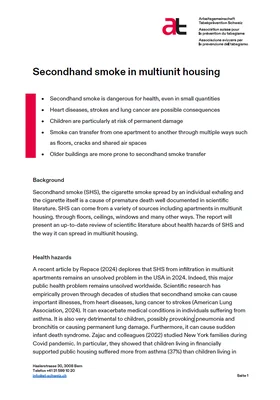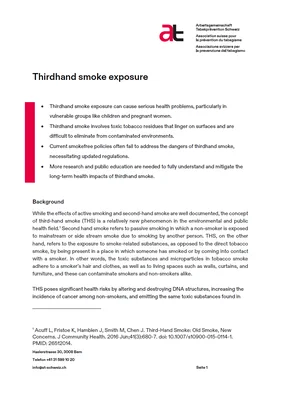Second-hand Smoke
The harmful effects of second-hand smoke have been recorded since 1928. In the 1970s, scientific interest in potential adverse health effects of second-hand smoke expanded. Since then, evidence about ill health because of second-hand smoke has accumulated from many studies done in different parts of the world. However, second-hand smoke remains an important and common indoor and outdoor air pollutant in many countries and public spaces.
Comprehensive legislation to protect non-smokers from exposure to second-hand smoke in all indoor workplaces and public places has been implemented in some countries, but 93% of the world’s population is still living in countries not covered by fully smoke-free public health regulations, including in Switzerland.
Second-hand Smoke Burden of Disease
Worldwide, researchers have estimated that second-hand smoke caused 603,000 deaths and 10.9 million disability-adjusted life years (DALYs) worldwide in 2004, corresponding to 1.0% of all deaths and 0.7% of the worldwide burden of disease in DALYs. Children are more heavily exposed to second-hand smoke than any other age group, and they are not able to avoid the main source of exposure—such as close relatives who smoke at home or in their cars. Furthermore, children are the group that has the strongest evidence of harm attributable to second-hand smoke.
Prevalence of Second-hand Smoke Exposure in Switzerland
A Swiss study showed that in 2009, 78% of 14- to 65-year-olds were exposed to tobacco smoke in restaurants: 13% for at least 3 hours per week, 23% 1 to 2 hours and 26% less than 1 hour per week. Ten percent (10%) of non-smokers were exposed to second-hand smoke for at least 3 hours per week.
The researchers stated that young people are the most exposed to tobacco smoke by others, which is partly due to their active social behaviour and frequent socialising with peers. Because of the above-average proportion of smokers in this age group, peers are particularly likely to meet smokers.
In the following year, on May 1, 2010, a weak and non-encompassing national law to protect people from passive smoking took effect in Switzerland. Since then, no more progress has been done in fighting passive smoke, and smoking is still possible in select areas indoors.
Third-hand Smoke
Third-hand smoke is the contamination that persists after second-hand tobacco smoke has been emitted into air. It refers to the tobacco-related gases and particles that become embedded in materials such as a smoker’s clothes, the carpet, walls, furniture, blankets and toys. Third-hand smoke is not strictly smoke, but chemicals that adhere to surfaces from which they can be released back into the air, undergo chemical transformations and/or accumulate.
Based on research carried out over the past few years, researchers have been able to conclude that tobacco smoke in the form of third-hand smoke is pervasive. Laboratory studies have demonstrated that the chemical reactions that take place during the aging of tobacco smoke residues produce secondary pollutants. Moreover, these third-hand smoke extracts were shown to inhibit cell proliferation and cell growth and caused damage to DNA and mitochondria in in vitro systems.
Children are the most susceptible to third-hand smoke related harm and tend to have more cough and sputum-related symptoms than non-exposed children.
Sources
CDC (2019): Going Smokefree Matters: Multiunit Housing. Online: //www.cdc.gov/tobacco/basic_information/secondhand_smoke/going-smokefree-matters/multi-unit/index.html, last updated on 12.07.2021, last checked on 12.07.2021.
Durham, A. D., Diethelm, P., & Cornuz, J. (2014). Why did Swiss citizens refuse a comprehensive second-hand smoke ban? Swiss medical weekly, 144.
Northrup, T. F., Jacob, P., 3rd, Benowitz, N. L., Hoh, E., Quintana, P. J., Hovell, M. F., Matt, G. E., & Stotts, A. L. (2016). Thirdhand Smoke: State of the Science and a Call for Policy Expansion. Public health reports (Washington, D.C. : 1974), 131(2), 233-238. https://doi.org/10.1177/003335491613100206
Öberg, M., Jaakkola, M. S., Woodward, A., Peruga, A., & Prüss-Ustün, A. (2011). Worldwide burden of disease from exposure to second-hand smoke: a retrospective analysis of data from 192 countries. The lancet, 377(9760), 139-146.
Radtke, T., Keller, R., Krebs, H., & Hornung, R. (2010). Passive smoking in the Swiss population 2009. Tobacco monitoring - Swiss survey on tobacco consumption.
Jacob III, P., Benowitz, N. L., Destaillats, H., Gundel, L., Hang, B., Martins-Green, M., ... & Whitehead, T. P. (2017). Thirdhand smoke: new evidence, challenges, and future directions. Chemical research in toxicology, 30(1), 270-294.
Download

